AMD’s Radeon HD 5850: The Other Shoe Drops
by Ryan Smith on September 30, 2009 12:00 AM EST- Posted in
- GPUs
Power, Temperature, & Noise
With Cypress pared down some for the 5850, the power/temperature/noise situation takes on a different look. The 5870 ended up being hot, noisy, and more power-hungry than any other single-GPU setup under load. Let’s see if the 5850 can avoid that.
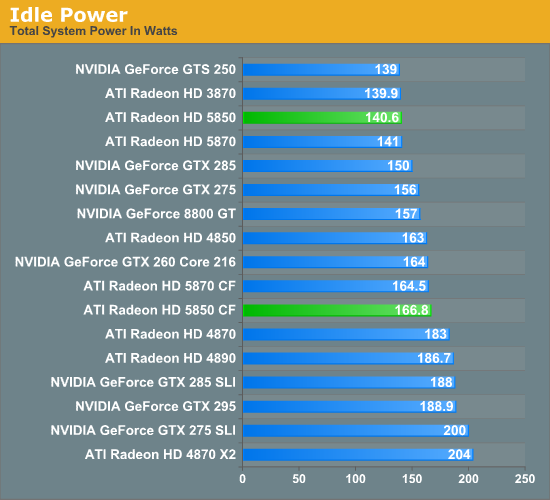
Looking at idle power, the results are the same as the 5870. This is to be expected as both are capable of reaching the same low idle power state. Crossfire results are similar, although the 5850 CF nudges itself higher than the 5870 CF on our charts; but this is within experimental variance.
As was the case with the 5870, the 5850 is among the lowest idling cards we have seen. It’s at the very bottom, only the Radeon HD 3870 and the GeForce GTS 250 can beat it, and even then just by a watt and a half.
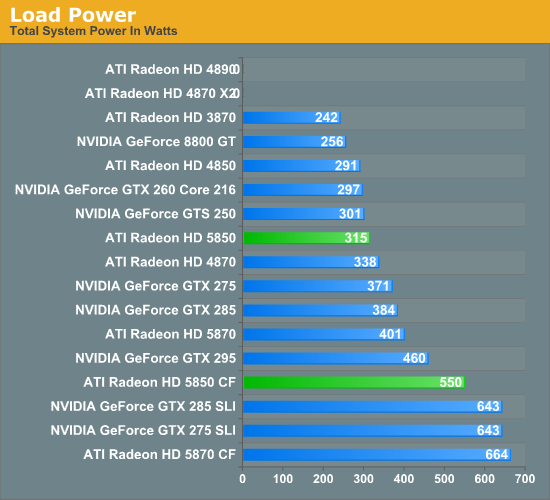
Load power on the other hand gives us a surprising difference. While the 5870 was one of the most power-hungry single-GPU cards we tested, the 5850 moves half-way down the chart. At load it uses less power than 4870 and most of the GTX series, in effect using less power than all of its closest performance competitors. In fact the difference in load power is beyond the specs; AMD’s specs call for a 37W difference, but here we have an 86W difference. Even after accounting for power supply inefficiencies, this is still a huge difference. We’re not seeing clock throttling occurring, so at this point we don’t have a complete explanation for what we’re seeing beyond the fact that we’re sure these are legitimate results.
The end result is that it’s clear that the 5850 is going to work well in systems with limited power abilities. At the same power envelope it’s significantly faster than anything else, and at the same performance level it’s significantly less power hungry than anything else.
As for Crossfire, this gap closes somewhat in that configuration. Here it’s only 114W under the 5870 CF, and just 93W under the GTX SLI cards. Even with its low power usage, the 5850 can’t erase the fact that multi-card solutions eat much more power than single-card solutions; it’s 90W over the GTX295, for example.
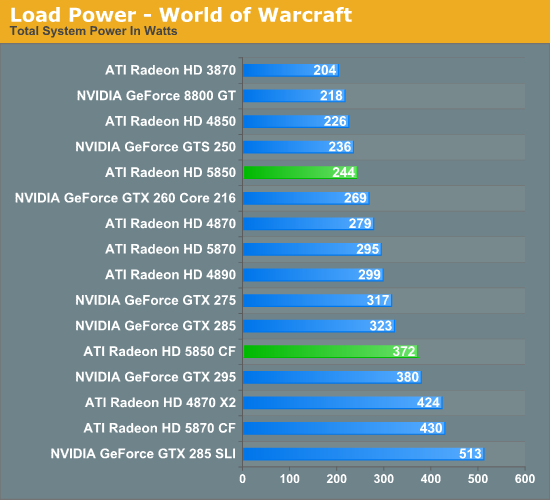
We’ll also take a look at power usage in Warcraft quickly, since it doesn’t trigger throttling in our other AMD cards. Warcraft doesn’t push these cards like OCCT does, so the overall power usage is lower, but the overall situation is virtually the same. The 5850 comes in at 55W less than the 5870, and this time bests the entire GTX lineup by at least 25W. We also see Crossfire do better here; now the 5850 CF can beat even multi-GPU cards like the 4870X2 and the GTX 295.
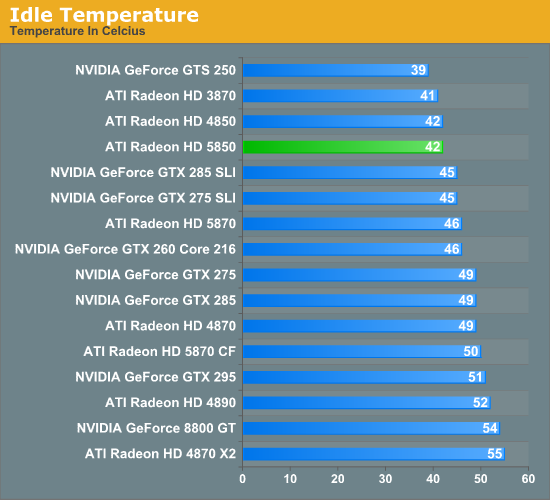
Interestingly enough, in spite of the same idle power as the 5870, the idle temps are not the same. The 5850 comes in at a chilly 42C, bringing it in line with the 4850 and the 3870. Only the GTS 250 can beat it by 3C, and in turn the 5850 beats its closest competitors, the GTX series, by at least 3C.
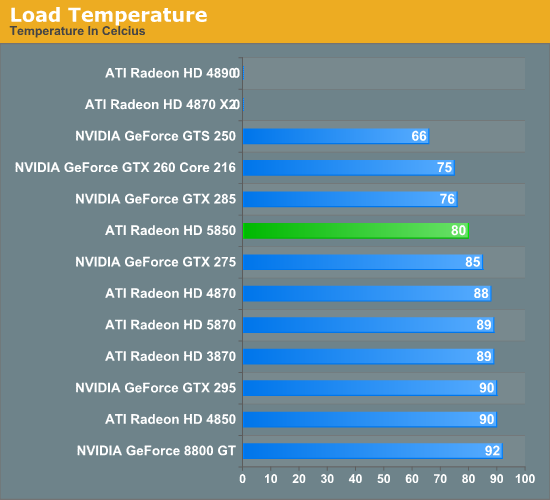
With lower power usage and a similar cooler, the 5850 is capable of keeping cooler than the 5870. While the 5870 approached 90C, the 5850 we’re testing was able to stay at 80C. This makes it the only AMD card we’ve tested that isn’t approaching 90C, which is good news for those of you with limited case ventilation. However it still loses to the GTS 250, and most of the GTX cards. We know NVIDIA is consuming more power, so clearly they have a more effective cooler in use if it’s able to cool their cards that well.
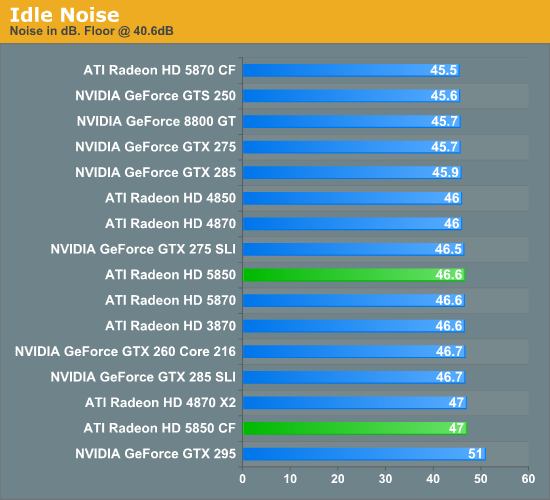
Finally we have noise. At idle virtually everything is the same, the 5850 and the 5870 come in at 46.6dB. To see a significant difference here, we would have to switch to a passively-cooled card.
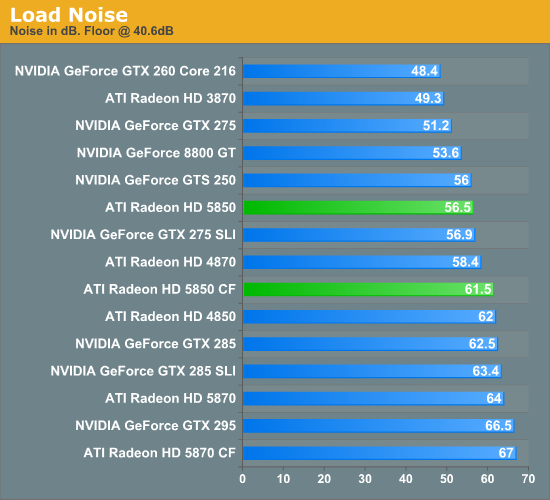
At load, the 5850 is just below the middle of the pack. Thankfully it’s not nearly as loud as the 5870, shaving off 8dB compared to its big brother and brings a Cypress-based card in to more reasonable territory. Adding a second card for Crossfire makes things louder at 61dB, but even that is still 6dB quieter than the 5870 CF.
This also shows us the tradeoffs NVIDIA made in cooling compared to AMD. The GTX 285, which was cooler running, is 6dB louder here as a result. Going by our charts the 5850 is fairly balanced in noise and temperature; it’s doesn’t need to make any trade-offs to achieve one or the other.










95 Comments
View All Comments
silverblue - Wednesday, September 30, 2009 - link
nVidia shouldn't "get out of the game" at all. True, ATI may just have 3 or 4 months of technical superiority, but nVidia's next cards may be superior as well as offering plenty of revolutionary features.nVidia can also chop prices for their current lineup but not too much, otherwise they may undercut their new cards.
I'm impressed by the 5850's frugal (as compared to the 5870) power requirements. Coupled with a relatively low price, it should sell very nicely indeed (and spawn some overclocked versions very quickly).
SJD - Wednesday, September 30, 2009 - link
Did you have the August DirectX Redist installed on your test system? I think I've read somewhere that this is the update that brings 'full' DirectX11 functionality to Windows 7, and perhaps this is the reason you didn't see the results you were expecting.Otherwise, awesome card!
Ryan Smith - Wednesday, September 30, 2009 - link
Based on AMD's internal data I suspect it's just the fact that we have everything cranked up. We're taking a look at it ASAP.Totally - Wednesday, September 30, 2009 - link
Ryan, could you retest the 5870 again but this time with a piece of tape running across the two 'vents' on the back of the card.Ryan Smith - Wednesday, September 30, 2009 - link
I'm curious what makes you think that will have any impact.Totally - Wednesday, September 30, 2009 - link
well, since it's a centrifugal fan, it sucks air through the center and exhausts it in a radial direction, being the shroud's job to redirect the air afterwards. now looking at how restricted the openings appear on the 5850 and the cooling performance. I'm curious if there is connection, say fresh air may be escaping through those openings and back into the case instead of passing through the heatsink and out the back of the case.Ryan Smith - Wednesday, September 30, 2009 - link
I don't have a good front-shot, but it's a sealed shroud. There's no air escaping.toast70 - Wednesday, September 30, 2009 - link
With 5870 being basically a doubled up 4870 architecture and (still SIMD), i am interested to see how Nvidia's new MIMD architecture will compete, especially with the ridiculous memory bandwidth it will have with GDDR5 and a 512 bit bus.(if the 512 bus isnt just a rumor and hopefully they are not plagued by driver issues) I am glad AMD/ATI is doing better the competition is great, but i feel the new NV cards are going to be good (least if any of the rumors are true). I am still trying to find a reason to replace my 9800GTX SLI, they burn thru about any game as long as you stay away from over 4X AA due to the 512 MB frame buffer.BTW, Not a NV fanboi here, hope i dont sound like one, its late and i just dropped my friend off at the ER, brain is tired. the fiancee's PC has a ATI card and its great, no complaints other than a few driver issues, but nothing i could complain about really. HD4850 512MB
keep up the competition, we have AMD to thank for under 400 fast cards
poohbear - Wednesday, September 30, 2009 - link
very well done review and the conclusion was spot on! gonna get one of these this fall, Nvidia better hurry up b4 shiat really hits the fan.:0Roland00 - Wednesday, September 30, 2009 - link
I wonder how close the 5850 will be to the 5870 once they have similar memory speeds and thus bandiwidth. Are those extra shaders/core frequency wasted due to the limited memory bandiwidth.